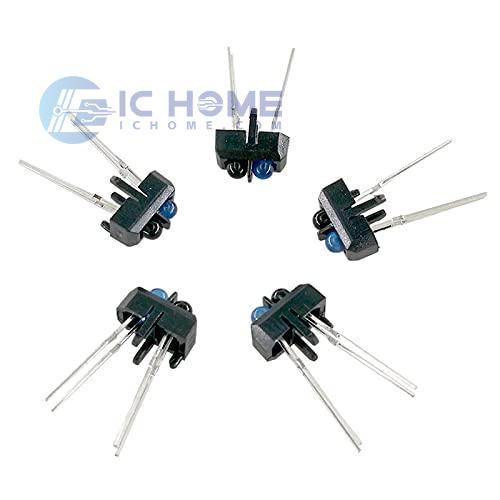Enhancing Precision in Sensing Applications with Reflective Optical Switches
Reflective optical switches are a vital component in electronic systems where precision, reliability, and compact design are required, such as in proximity sensing, object detection, and automation. Their versatility, which stems from their unique configuration of light emission and reflection detection, makes them highly useful in applications where standard through-beam or retroreflective sensors may not be ideal. This article explores the different aspects of reflective optical switches, including popular part numbers, manufacturers, key applications, and their packages and cases.

Manufacturer and Key Model Numbers
Several leading manufacturers, such as Omron, Honeywell, and Broadcom, have developed reflective optical switches that support an array of applications. Notably:
The Omron EE-SX series is a well-known range of reflective optical switches designed for accurate detection in various industrial settings. These sensors offer high durability, with models available in various packaging formats, making them ideal for use in complex machinery and robotics.
Honeywell's HOA series provides flexibility with multiple configuration options, from slot-type reflective switches to low-profile designs. Known for their robust build and sensitivity, the HOA switches are frequently employed in applications requiring compact and reliable optical sensing solutions.
These models represent some of the top options on the market, known for their consistent performance, durability, and versatility.
Applications of Reflective Optical Switches
Reflective optical switches find widespread use in applications across industrial automation, robotics, and consumer electronics due to their ability to detect objects without contact. Here are some key applications:
Proximity Sensing in Automation
Reflective optical switches are commonly used in automated systems to detect the presence or absence of objects. Their sensitivity and compact form factor make them ideal for assembly lines, where they can detect objects quickly and accurately, even in restricted spaces. In automation settings, reflective switches often serve as sensors for quality control, detecting products moving along conveyors and ensuring correct alignment.
Object Detection in Robotics
Robotics often requires components that provide real-time data on an object's position and proximity. Reflective optical switches serve this purpose well, offering robots the ability to interact with their environment safely and effectively. For example, in robotic arms used for assembling small components, these switches provide feedback for exact placement, enhancing precision and reducing errors.
Consumer Electronics
Reflective optical switches are also popular in consumer electronics, where they are often used to detect the presence of objects near a device, such as screens or touch panels. They can help optimize battery usage by turning off displays when no user is detected, and in some devices, they enhance user interaction by responding to hand gestures or proximity cues.
Reflective optical switches are invaluable for applications demanding non-contact sensing. Their reliability in various environmental conditions and ability to detect objects without physical interaction make them highly adaptable across industries.
Technical Overview: How Reflective Optical Switches Work
Reflective optical switches operate based on the principle of emitted light being reflected back to a detector. The light-emitting diode (LED) in the switch emits a beam of light toward a target surface. When an object interrupts the path, the emitted light reflects back toward a photodetector within the switch. This reflected light triggers an electronic signal, which in turn can be processed to execute further actions in a system.
These switches typically consist of:
LED Emitter – Produces a beam of light directed toward the object or reflective surface.
Photo Detector – Senses the reflected light and sends a signal.
Electronic Processor – Analyzes the signal to determine object presence or distance.
This mechanism allows for quick response times, reliable performance, and high sensitivity, which are essential in automated and high-speed systems.
Packaging and Casing Considerations
The package and casing of reflective optical switches are critical as they influence both performance and durability in different environments. Manufacturers provide various packaging options to suit specific application needs:
Surface-Mount Packages
Surface-mount packages are compact and ideal for applications requiring high-density mounting, such as in consumer electronics and robotics. Their small footprint allows for efficient space utilization, which is a key consideration in portable devices or tightly packed industrial setups.
Through-Hole Packages
Through-hole packages provide robustness and ease of maintenance, making them ideal for industrial environments where durability is paramount. These packages are typically used in larger equipment and machinery where the components may be exposed to harsher conditions.
Hermetically Sealed Cases
For applications that demand protection from dust, moisture, and extreme temperatures, hermetically sealed cases are available. These provide added resilience in environments where contaminants are a concern, such as in outdoor installations or factories with high particulate matter.
The choice of package and casing ensures that reflective optical switches can function optimally and remain operational across a broad spectrum of environments, enhancing their versatility and applicability.
Conclusion
Reflective optical switches have cemented their role in various industries, from automation and robotics to consumer electronics. With advances in miniaturization and enhanced sensitivity, these switches are now more efficient, versatile, and durable, meeting the growing demands of modern applications. Manufacturers like Omron, Honeywell, and Broadcom continue to innovate, ensuring that these switches remain an essential part of the electronic component landscape.
For procurement professionals and engineers, selecting the right reflective optical switch involves considering factors like application requirements, environmental conditions, and packaging needs. By leveraging the capabilities of these highly adaptable sensors, industries can achieve greater precision and efficiency, pushing the boundaries of automated and sensing technologies even further.
For more information or to request a quote, please feel free to send us an RFQ.




